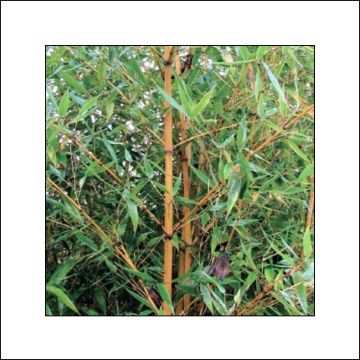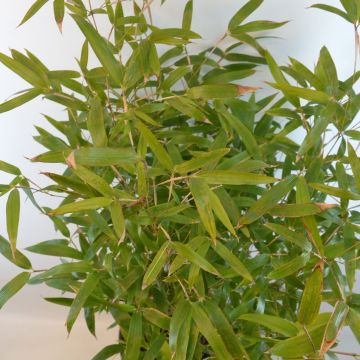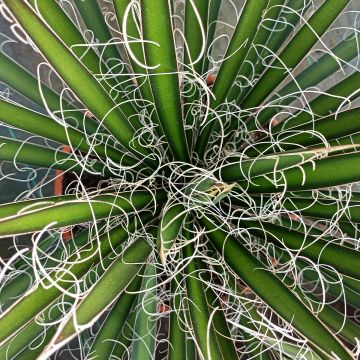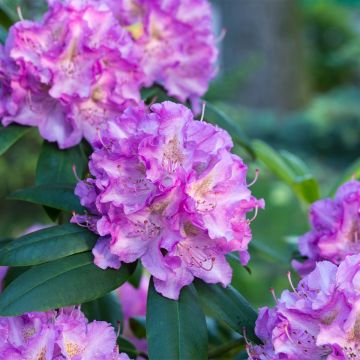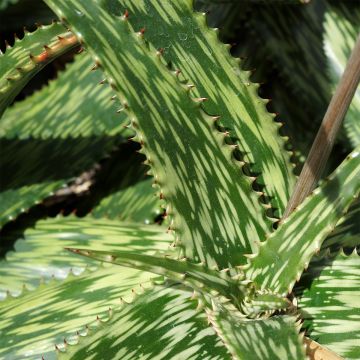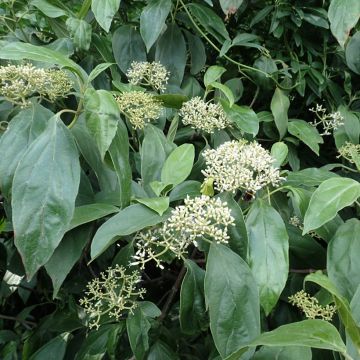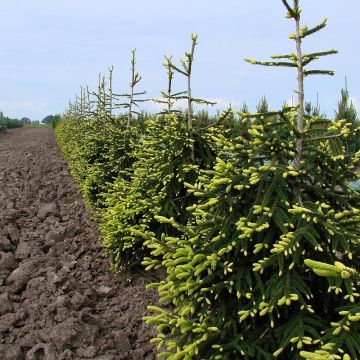

Phyllostachys flexuosa -Sinuate Bamboo


Phyllostachys flexuosa -Sinuate Bamboo
Phyllostachys flexuosa -Sinuate Bamboo
Phyllostachys flexuosa
Sinuate Bamboo
This item cannot be shipped to the selected country
Oversize package delivery charge from €6.90
More information
Schedule delivery date,
and select date in basket
This plant carries a 24 months recovery warranty
More information
We guarantee the quality of our plants for a full growing cycle, and will replace at our expense any plant that fails to recover under normal climatic and planting conditions.
Oversize package: home delivery by special carrier from €6.90 per order..
Express home delivery from €8.90.
Does this plant fit my garden?
Set up your Plantfit profile →
Description
Phyllostachys flexuosa is an extremely ornamental medium-sized bamboo. Its flexible habit allows it to form spreading clumps, with the tops of the culms appearing to bend under the weight of the delicate foliage. It grows rapidly, forming thin canes that are green to yellow in color depending on sunlight, always very decorative. While most Phyllostachys prefer neutral to acidic soils, P. flexuosa has the interesting characteristic of tolerating limestone. Even more surprising, it can even withstand salt spray and slightly salty soils, making it perhaps the most well-suited species for coastal areas. In addition to being very accommodating, it is very hardy and tolerates dry conditions quite well.
This bamboo belongs to the Poaceae, or Grasses, family. While some species can reach heights of tens of metres and form culms as hard as wood, they are not trees, but rather grasses. There are over a thousand species, distributed on all continents except Antarctica.
Phyllostachys flexuosa is native to central China, where it grows in different provinces of Henan, Shaanxi, and Hubei. It is a medium-sized species that generally reaches 4 to 6m (13 to 20ft) in height, with a width of 2 to 3m. Aesthetically, its uniqueness lies in its particularly graceful and flexible habit, as its species name suggests. This bamboo is indeed extremely flexible, with the culms arching at their tips, forming beautiful clumps that resemble a vegetal fireworks display. The foliage is a lovely green, quite bright and dense, forming ample draperies that undulate in the wind. The culms have a diameter of 2 to 4cm (1 to 2in) and their colour depends on sunlight: in partial shade, they are green, while in full sun, they turn yellow. In any case, they are very decorative, both in terms of their colour and the delicate curves they form as they bend in their upper half.
Easily identifiable by its flexible habit, this species is also distinct from others in terms of its cultural characteristics. Phyllostachys generally require a neutral to acidic soil, remaining moist (but well-drained) to thrive, which limits their use somewhat. This one will interest owners of limestone soils, as it adapts well to these growing conditions. It is also very suitable for coastal areas, as it tolerates salt spray and even slightly salty soils. Similarly, it tolerates drought better than others, which is not surprising given that the physiological adaptation mechanisms are similar to those for limestone or salt tolerance.
Rather indifferent to soil type, this Phyllostachys grows equally well in full sun or partial shade, for example at the edge of large trees. It is not afraid of wind and withstands cold temperatures very well, as it can endure freezes down to -23°C (1°F). Only excessive water in poorly drained soil is harmful to it, as is the case for most other species (except P. heteroclada). This bamboo is therefore extremely adaptable and can be planted in almost any garden. Although it spreads moderately, it is still advisable to limit its spread in small areas with a rhizome barrier, which should encircle the clump and extend about ten centimetres above the soil surface.
Being well-suited to pruning, this bamboo can potentially be planted as a hedge, but it is in clumps or as a standalone plant that it will provide the most beautiful spectacle. Its beauty lies in its arching habit, so it would be a shame to trim it when there are other species that are naturally more upright and better suited for hedge formation. The cascading foliage will be perfect for creating a Japanese scene. Thus, in mild coastal climates, it can be associated with Pittosporum tobira, an evergreen shrub with white flowers emitting a sweet fragrance, which is also resistant to salt spray. In colder regions, Trachycarpus fortunei, or Windmill Palm, with its sturdy trunk covered in fibres, will also be a perfect companion for creating an Oriental atmosphere. And to add colour to this range of green, nothing beats a Japanese flowering cherry tree like the famous Prunus serrulata 'Kanzan', always appreciated for its multitude of double pink flowers in spring and its beautiful autumnal colours.
Report an error about the product description
Phyllostachys flexuosa -Sinuate Bamboo in pictures


Plant habit
Foliage
Botanical data
Phyllostachys
flexuosa
Poaceae
Sinuate Bamboo
China
Other Phyllostachys
Planting and care
Grown in containers, bamboo can be planted at any time of the year, except during freezing temperatures. However, the best planting period is late summer and autumn, when the soil is warmed up and rainfall is more frequent.
Phyllostachys flexuosa can be planted in almost all types of soil, as it tolerates limestone well - which is uncommon in this genus - and even slightly salty soils. It also adapts to poor and relatively dry terrains, and since it is hardy up to -23°C (1°F), it can reasonably be said to be one of the most accommodating species.
Therefore, you can plant it wherever you want, in sunny or semi-shady locations, while keeping in mind that it spreads through rhizomes and will expand over the years. A rhizome barrier will limit its spread without completely preventing it... Choose a location accordingly, where it will have enough space to grow well. Soak the rootball in a bucket before planting to thoroughly moisten it, then once positioned in the planting hole, backfill and water generously. Water regularly for the first 2 years, until the plant is well established, and then occasionally during long dry periods, as this bamboo is quite drought-resistant.
Planting period
Intended location
Care
This item has not been reviewed yet - be the first to leave a review about it.
Evergreen shrubs
Haven't found what you were looking for?
Hardiness is the lowest winter temperature a plant can endure without suffering serious damage or even dying. However, hardiness is affected by location (a sheltered area, such as a patio), protection (winter cover) and soil type (hardiness is improved by well-drained soil).

Photo Sharing Terms & Conditions
In order to encourage gardeners to interact and share their experiences, Promesse de fleurs offers various media enabling content to be uploaded onto its Site - in particular via the ‘Photo sharing’ module.
The User agrees to refrain from:
- Posting any content that is illegal, prejudicial, insulting, racist, inciteful to hatred, revisionist, contrary to public decency, that infringes on privacy or on the privacy rights of third parties, in particular the publicity rights of persons and goods, intellectual property rights, or the right to privacy.
- Submitting content on behalf of a third party;
- Impersonate the identity of a third party and/or publish any personal information about a third party;
In general, the User undertakes to refrain from any unethical behaviour.
All Content (in particular text, comments, files, images, photos, videos, creative works, etc.), which may be subject to property or intellectual property rights, image or other private rights, shall remain the property of the User, subject to the limited rights granted by the terms of the licence granted by Promesse de fleurs as stated below. Users are at liberty to publish or not to publish such Content on the Site, notably via the ‘Photo Sharing’ facility, and accept that this Content shall be made public and freely accessible, notably on the Internet.
Users further acknowledge, undertake to have ,and guarantee that they hold all necessary rights and permissions to publish such material on the Site, in particular with regard to the legislation in force pertaining to any privacy, property, intellectual property, image, or contractual rights, or rights of any other nature. By publishing such Content on the Site, Users acknowledge accepting full liability as publishers of the Content within the meaning of the law, and grant Promesse de fleurs, free of charge, an inclusive, worldwide licence for the said Content for the entire duration of its publication, including all reproduction, representation, up/downloading, displaying, performing, transmission, and storage rights.
Users also grant permission for their name to be linked to the Content and accept that this link may not always be made available.
By engaging in posting material, Users consent to their Content becoming automatically accessible on the Internet, in particular on other sites and/or blogs and/or web pages of the Promesse de fleurs site, including in particular social pages and the Promesse de fleurs catalogue.
Users may secure the removal of entrusted content free of charge by issuing a simple request via our contact form.
The flowering period indicated on our website applies to countries and regions located in USDA zone 8 (France, the United Kingdom, Ireland, the Netherlands, etc.)
It will vary according to where you live:
- In zones 9 to 10 (Italy, Spain, Greece, etc.), flowering will occur about 2 to 4 weeks earlier.
- In zones 6 to 7 (Germany, Poland, Slovenia, and lower mountainous regions), flowering will be delayed by 2 to 3 weeks.
- In zone 5 (Central Europe, Scandinavia), blooming will be delayed by 3 to 5 weeks.
In temperate climates, pruning of spring-flowering shrubs (forsythia, spireas, etc.) should be done just after flowering.
Pruning of summer-flowering shrubs (Indian Lilac, Perovskia, etc.) can be done in winter or spring.
In cold regions as well as with frost-sensitive plants, avoid pruning too early when severe frosts may still occur.
The planting period indicated on our website applies to countries and regions located in USDA zone 8 (France, United Kingdom, Ireland, Netherlands).
It will vary according to where you live:
- In Mediterranean zones (Marseille, Madrid, Milan, etc.), autumn and winter are the best planting periods.
- In continental zones (Strasbourg, Munich, Vienna, etc.), delay planting by 2 to 3 weeks in spring and bring it forward by 2 to 4 weeks in autumn.
- In mountainous regions (the Alps, Pyrenees, Carpathians, etc.), it is best to plant in late spring (May-June) or late summer (August-September).
The harvesting period indicated on our website applies to countries and regions in USDA zone 8 (France, England, Ireland, the Netherlands).
In colder areas (Scandinavia, Poland, Austria...) fruit and vegetable harvests are likely to be delayed by 3-4 weeks.
In warmer areas (Italy, Spain, Greece, etc.), harvesting will probably take place earlier, depending on weather conditions.
The sowing periods indicated on our website apply to countries and regions within USDA Zone 8 (France, UK, Ireland, Netherlands).
In colder areas (Scandinavia, Poland, Austria...), delay any outdoor sowing by 3-4 weeks, or sow under glass.
In warmer climes (Italy, Spain, Greece, etc.), bring outdoor sowing forward by a few weeks.







































